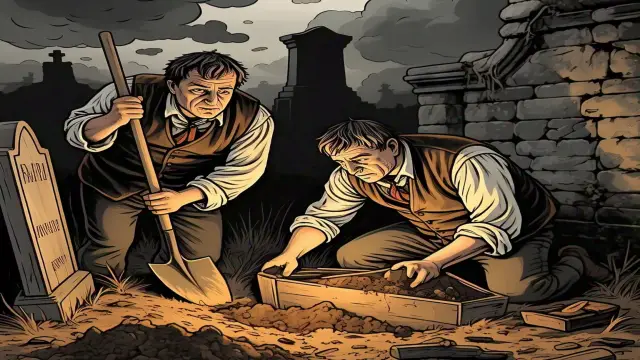The story of Burke and Hare is one of the most chilling chapters in 19th-century history. What began as a grim trade in stolen corpses escalated into a series of brutal murders that shocked Edinburgh and beyond. This is the tale of their crimes, their victims, and the dark world of body snatching that fueled their atrocities.
The Rise of the Resurrectionists
In the early 19th century, medical schools needed bodies for anatomical study. However, legal supplies were limited. This demand gave rise to resurrectionists—grave robbers who dug up freshly buried corpses to sell to medical institutions.
While the public despised these crimes, they were seen as a necessary evil. But Burke and Hare took this dark trade to a horrifying new level.
From Grave Robbers to Murderers
William Burke and William Hare were Irish immigrants living in Edinburgh. They started as laborers but soon found a more profitable—and sinister—line of work.
Their first opportunity came in 1827 when a lodger in Hare’s boarding house died owing rent. Instead of burying him, they sold his body to Dr. Robert Knox, a prominent anatomist. This marked the beginning of their deadly partnership.
The Murder of Mary Docherty
Burke and Hare’s crimes reached a new low with the murder of Mary Docherty. On Halloween 1828, Burke met the elderly Irishwoman in a grocery shop. Claiming to be her long-lost relative, he lured her to his home.
After a night of drinking and dancing, Burke and Hare suffocated Mary while she slept. They hid her body in a straw pile and sold it to Dr. Knox the next day.
The Grays’ Discovery
James and Ann Gray, lodgers at Burke’s home, grew suspicious when Mary Docherty suddenly disappeared. Their curiosity led them to uncover her body hidden in the straw.
Despite attempts by Burke, Hare, and their wives to bribe the Grays into silence, the couple refused. They reported the crime, setting off a chain of events that would bring Burke and Hare to justice.
The Downfall of Burke and Hare
The discovery of Mary Docherty’s body sparked an investigation. Burke and Hare were arrested, along with their wives, Helen McDougal and Margaret Hare.
Facing trial, Hare struck a deal with prosecutors. He testified against Burke in exchange for immunity. Burke was found guilty and sentenced to death.
The Execution of William Burke
On January 28, 1829, William Burke was hanged in front of a massive crowd in Edinburgh. His body was publicly dissected, and his skeleton remains on display at the University of Edinburgh’s Anatomical Museum.
Hare, though spared execution, was released and disappeared into obscurity. The fate of their wives is less clear, but they were never convicted of murder.
The Legacy of Burke and Hare
The crimes of Burke and Hare exposed the dark side of 19th-century medical science. Their actions led to the Anatomy Act of 1832, which regulated the supply of bodies for medical study and ended the era of resurrectionists.
Their story remains a cautionary tale of greed, desperation, and the lengths to which people will go for profit.
Conclusion: A Dark Chapter in History
The tale of Burke and Hare is a grim reminder of a time when medical progress came at a horrifying cost. Their crimes shocked the world and led to lasting changes in law and society.
As we reflect on this dark chapter, we are reminded of the importance of ethics, justice, and the value of human life.
Engage with History
Visit Edinburgh’s landmarks tied to Burke and Hare, such as the University of Edinburgh’s Anatomical Museum. Share their story to keep history alive and learn from the past.

